Explore the very best temples, tombs and timeless landscapes of Egypt with our epic 2 week Egypt itinerary, travelling from Cairo to Aswan and Luxor.
Short of travelling through time, to journey through Egypt is about as close as you can physically get to the ancient past of one of our oldest and earliest civilisations.
This extraordinary country is home to some of the greatest and best preserved ancient temples and tombs in the world, along with spectacular landscapes, and a people whose cultures and traditions have developed alongside the mighty River Nile over thousands of years.
Egypt is a country that keeps calling us back. Between the two of us, we’ve been lucky enough to visit Egypt multiple times now and we’ve travelled through the country both independently and on tour. There’s always more to see and more we want to do. There’s always a plan to return.
While we prefer slow travel and absolutely recommend giving as much time as you can to a visit, if you have just 2 weeks in Egypt, this independent travel itinerary will introduce you to the best of the best – the greatest hits – of this ancient place.
You’ll get to see Egypt’s most famous and enduring sites, from the Great Pyramid of Giza and the even more ancient step pyramid of Djoser in the country’s north, to the incredible temples of Karnak and Abu Simbel in the south. You’ll experience vivid tombs in the Valley of Kings in Luxor, sail the Nile at sunset in Aswan and immerse in the dramatic and timeless landscapes of Egypt with a quintessential Nile River cruise.
Rest assured, after this trip, Egypt will be calling you back too.
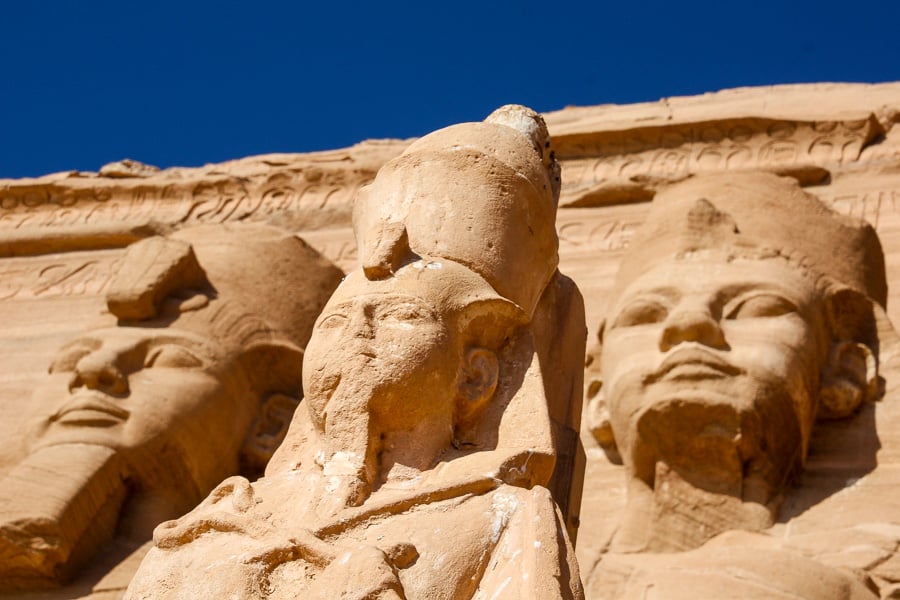
2 Week Egypt Itinerary Snapshot
Start: Cairo, Egypt
Finish: Luxor, Egypt
Length: This itinerary requires a full two weeks. If you have less time or more time, we’ve made some suggestions for how to plan your itinerary further on.
Overnight stops: 4 nights in Cairo, 1 night sleeper train, 2 nights in Aswan, 3 nights on a Nile Cruise, 3 nights in Luxor.
Transport: This itinerary involves cars, a sleeper train, planes and boats.
What’s in this post?
Planning a visit to Egypt
Getting to Cairo
Best time to visit Egypt
What’s the route?
If you have less time to visit Egypt
If you have more than 2 weeks in Egypt
2 Week Egypt Itinerary
Day 1 – Arrive Cairo
Day 2 – Pyramids of Giza & Egyptian Museum
Day 3 – Cairo Highlights
Day 4 – Alexandria
Day 5 – Memphis, Saqqara & Dahshur
Day 6 – Aswan
Day 7 – Abu Simbel
Days 8 to 11 – Nile Cruise
Day 12 & 13 – Luxor
Day 14 – Depart Luxor
This post contains affiliate links. If you find these links useful and you choose to purchase through these links we may receive a small commission, at no extra cost to you, which helps us to keep this website running. Your support is much appreciated!
Planning a visit to Egypt
Getting to Cairo
This itinerary starts in Cairo, Egypt’s capital city. Most international travellers will fly into Cairo International Airport.
This is the busiest airport in Africa and a major hub for the region so give yourself plenty of time navigating your way in, around and out of here. The airport is around 20 kilometres (12.5 miles) north-east of downtown Cairo, though traffic can make it feel a lot further away.
Check flight routes and prices for flying in and out of Cairo.
There are a number of other airports in Egypt servicing popular tourist areas like Luxor, Hurghada and Sharm el-Sheik with both domestic and international flights.
As this itinerary finishes in Luxor, you might consider flying from Luxor back to Cairo for your connecting flight home, or seeing whether there are flights from Luxor to an airport near you. You could also extend your trip and fly out of Luxor to somewhere else in Egypt.
Best time to visit Egypt
If you’re planning a trip to Egypt, the best time to visit is between October and March, when the generally hot and dry climate is a bit kinder.
Peak travel time is December and January and the prices of accommodation and travel will reflect this, plus places book up quickly. Plan well ahead if you’re intending to visit over this period.
The shoulder periods of March, April and September are also good times to travel as it will be less crowded at the major sites, but the temps aren’t quite as oppressive as they are over the summer period between May and August. Those hot months are still fine for travel if you don’t mind the heat, just be prepared and avoid being outdoors during the hottest hours of the day.
We’ve visited Egypt in January, October and November and found the temps to be pretty pleasant, though it was still pretty hot out on the Giza plateau and on Luxor’s West Bank during the day. Nights can get cool during the winter months in Cairo and Alexandria, and very cold in the desert.
What’s the route?
If you follow this Egypt itinerary, you’ll need a full two weeks. You’ll start with a couple of days in Cairo, visiting the Pyramids of Giza and the city’s historic sites and museums. You’ll also day trip south to the vast Necropolis of Saqqara and north to the ancient city of Alexandria.
Then you’ll take the overnight train south to Aswan, visiting the epic attractions here and day tripping to the extraordinary temple complex of Abu Simbel.
From Aswan, you can opt to spend the next couple of days aboard a Nile Cruise heading back north, taking in the timeless landscapes and temples along the Nile between Aswan and Luxor, including the highlight sites of Karnak Temple and the Valley of the Kings. Alternatively, you can overland between Aswan and Luxor instead.
Your last couple of days will be spent exploring more of the wonders in and around Luxor before winding up your itinerary in this Nile-side city.
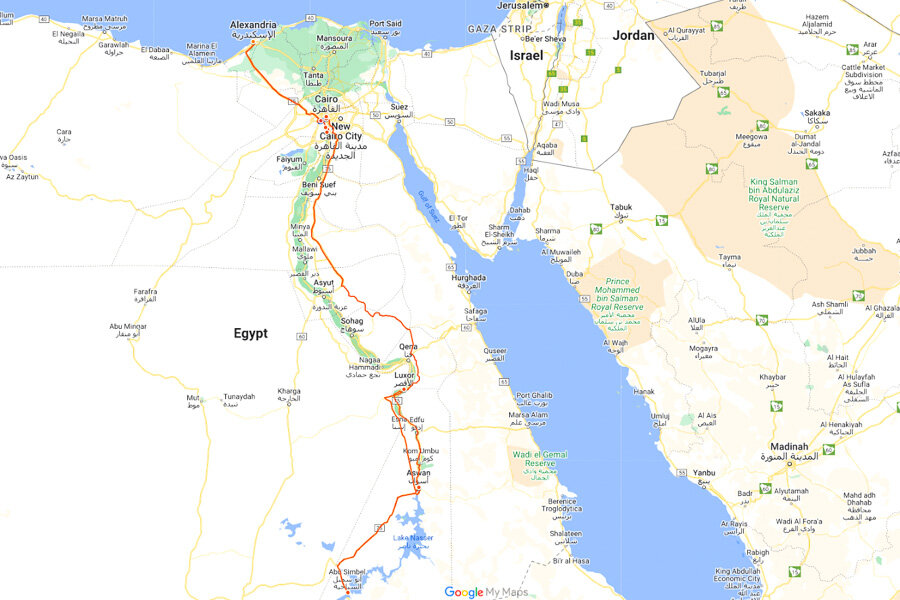
If you have less time to visit Egypt
If you have a week or so in Egypt, we would suggest visiting Cairo for a couple of days and Luxor for a couple of days, flying between the two cities, and possibly doing a day trip to Abu Simbel.
If you have more than 2 weeks in Egypt
With more than 2 weeks in Egypt, we would recommend a longer, more in-depth Nile Cruise such as this 6 day dahabiya cruise that we did on one of our trips. Dahabiyas can dock in places the bigger cruise boats can’t, and we visited a whole range of smaller, off-the-beaten-path ancient sites and villages along the Nile. This will always be one of our favourite Egypt experiences.
If you wanted to incorporate a longer Nile Cruise into this two week itinerary in Egypt, you could do so by shortening your stay in Cairo and skipping Alexandria.
With 3 weeks in Egypt or more, you might consider adding a 2-day overnight trip to the Bahariya Oasis and White Desert out of Cairo, and/or flying out of Luxor for a couple of days in one of Egypt’s Red Sea resort areas, like Hurghada, Sharm el-Sheik or – our personal favourite – the low-key village and scuba diving hub of Dahab on the Sinai Peninsula.
Safety in Egypt
Safety always comes up when people ask us for advice on visiting Egypt. Tourism is vital to the country’s economy and the government takes the safety of visitors very seriously. You may notice a military and police presence in many places you go, particularly at the main tourist sites.
We’ve never felt unsafe on our travels there, and we’ve visited during some turbulent periods. Like anywhere, it’s important to stay abreast of what’s happening before you visit and while you’re in the country. Also keep tabs on the travel advice for Egypt provided by your home country.
Ancient Egypt’s Greatest Hits: 2 Week Egypt Itinerary
Days 1 to 3: Cairo
Cairo is Egypt’s vast, frenetic capital city and it’s the launchpad for our 2 weeks in Egypt. The city’s densely populated urban sprawl is home to more than 22 million people. From the moment you arrive, you can’t help but be swept up in the all-senses chaos and pace. Welcome to the beating heart of Egypt!
Day 1 – Arrive in Cairo
Highlights: Pyramids Sound & Light Show
Overnight: Cairo
If you’re flying into Cairo International Airport, you have a couple of options for making the 25 kilometre (15.5 mile) journey from the north-east to your hotel: public bus, taxi, Uber or private transfer.
The easiest (albeit usually the most expensive) option, and generally our option of choice when arriving in a new and unfamiliar country, is to arrange a private transfer. Taxi drivers will bombard you when you exit the arrivals hall at the airport. It’s much less hassle to have someone waiting for you when you arrive. You can arrange a transfer through your hotel in advance, or check prices for transfers from Cairo Airport here.
Travel Tip: If you plan to rely on wifi during your trip, download offline Google maps for Cairo, Luxor and Aswan before you arrive.
We got lost in Downtown Cairo on our first day there together. Thankfully some lovely locals helped us find our accommodation again but having offline maps would have made a big difference.
There’s a good chance your flight won’t arrive until this afternoon, and with Cairo’s intense traffic and congestion, it’s likely to take an hour or so to reach your hotel. So if you arrive late afternoon, rest up and be ready for your Cairo itinerary to start in earnest tomorrow.
If you do arrive in the morning and you’re keen to get out and explore some Cairo highlights, check out Day 3 for ideas.
If you have the evening free, you might consider the Pyramids Sound and Light Show, which takes place around 7.30pm in English from Wednesday to Saturday. We haven’t done this and, to be honest, sound and light shows aren’t usually our thing, but these are the pyramids after all so if you do go, we’d love to know what you think. Visit the official Sound and Light Show website for ticket information.
Where to stay in Cairo
Depending on your priorities and budget, the key areas to stay in Cairo are Downtown, Garden City, Giza and Zemalek.
Downtown Cairo, on the east-side of the Nile, is the most convenient for access to the Egyptian Museum and Tahrir Square. It’s also a short drive from other attractions like Coptic Cairo, the Citadel and Khan el-Khalili bazaar. You’ll find more budget stays in this area.
Just south of Downtown is Garden City, a more upscale area with grand, early 20th century architecture and some lovely Nile-side hotels.
If you want to wake up to the pyramids, then look to Giza on the west bank of the Nile. It’s worth noting that while the pyramids are the accommodation drawcard here, and it’s also convenient for trips to Memphis and Saqqara, this area is further from Cairo’s other attractions, which means more time in taxis and traffic. That said, with the Great Egyptian Museum set to fully open this year in Giza, there will be even more reason to stay on this side of the river.
In between them all is Zemalek, an affluent area on Gezira Island in the middle of the Nile. This is where a number of embassies are located, along with lots of expats. Apparently it’s a great spot for dining.
We’ve stayed in the Downtown area on our visits to Cairo and we’ve found it to be a good base. Our accommodation choices have been pretty basic though and we’ll opt for something different next time. Here are a couple of suggested Cairo stays with excellent reviews:
- Budget (Downtown): Tahrir Square Hostel
- Mid-range (Garden City): Kempinski Nile Hotel
- Luxury (Giza): Marriott Mena House
- Bonus Budget (Giza): Sunrise Pyramids View Inn
Day 2 – Pyramids of Giza & Grand Egyptian Museum
Highlights: Pyramids of Giza | Great Sphinx | Grand Egyptian Museum
Overnight: Cairo
Morning – Pyramids & Great Sphinx
Plan to get started early today. The Pyramids of Giza site opens at 8am from October to March and 7am from April to September. We recommend being there for opening to get ahead of the crowds and the heat, both of which build as the day progresses.
You can arrange a guided tour of the Pyramids. Or you can taxi or Uber to the site and explore independently, which is what we did.
There are two entrances, on the north side near the Great Pyramid and on the east side in front of the Sphinx. For that classic Sphinx-in-front-of-Pyramid pic, we suggest entering via this gate. It’s also less busy but it does involve a 3km (1.9 mile) uphill walk to the Great Pyramid.
There’s a lot more to the Giza Necropolis than the pyramids, so aim to spend at least 3 to 4 hours here. With that amount of time, you’ll be able to visit the three pyramids of Khufu, Khafre and Menkaure (and head inside one of them if you don’t mind queuing and small spaces; there’s an extra cost for this), as well as the Queens Pyramids, the Worker’s Village, some of the smaller temples and, of course, the Great Sphinx.
We’ve learned that the remarkable Solar Boat of Khufu, which once filled a dedicated hangar near the Great Pyramid, has been relocated nearby to the new Grand Egyptian Museum.
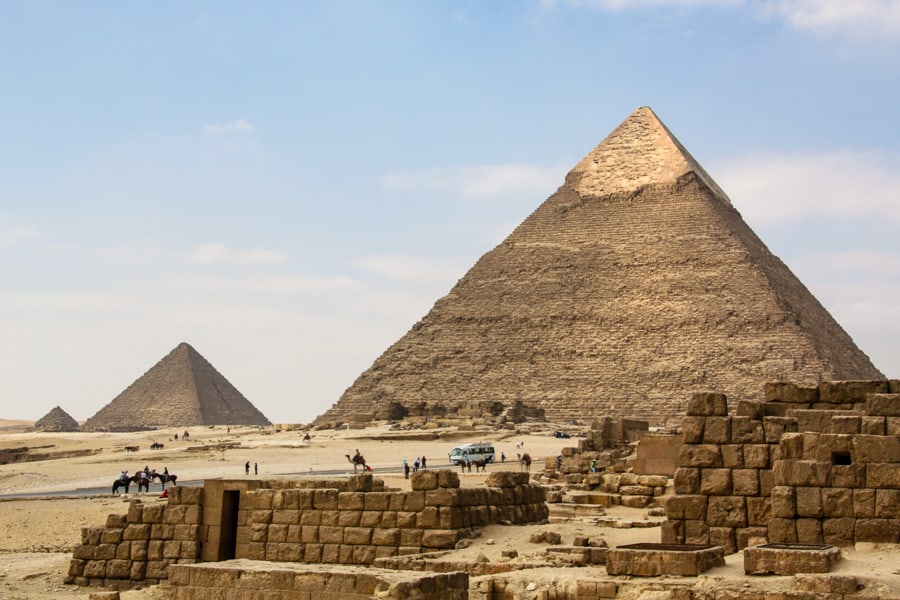
Travel Tip: Be prepared for some serious hassle at the Pyramids of Giza, especially if you’re visiting independently. The pressure from touts can be intense, whether it’s to buy a souvenir, have your photo taken with a camel or ride a horse or camel into the desert.
Plan ahead of time what you want to do at the site and be polite but firm when responding. If you don’t intend to buy or ride, say ‘no’ from the outset rather than ‘maybe later’ or, as we experienced, you’ll end up with a persistent entourage for most of your visit. Remember, nothing is really ‘free’.
Afternoon – Grand Egyptian Museum, Giza Plateau
It’s been years in the making, but the Grand Egyptian Museum (GEM), a vast and impressive new artefacts hangar, has finally opened its doors on the Giza Plateau.
Actually, GEM is yet to officially open, but most of its galleries and exhibition halls can now be visited. You’ll find thousands of artefacts here spanning Ancient Egypt’s long story, in an architecturally striking building with views to the Pyramids.
The one exhibition hall that isn’t open yet – and the showstopper for which GEM has been purpose-built – is the Tutankhamun Gallery. Ultimately, this exhibition will showcase the entire contents of King Tut’s tomb and it will be epic.
For now though, you can still see Tut’s treasures at the old Egyptian Museum at Tahrir Square and we’ve included that as an option for Day 3.
A visit to GEM goes hand in hand with a trip to Giza and the Pyramids. But if Tut takes precedence, then while the exhibition resides at the Tahrir Square museum, consider heading there instead this afternoon.
For more info about times, tickets and guided tours for GEM, head to the website.
Day 3 – Cairo Highlights
Highlights: King Tut’s Treasures | Royal Mummies | Cairo Citadel | Coptic Cairo | Khan el-Khalili Bazaar
Overnight: Cairo
For many visitors, Cairo is just a transit point to Egypt’s ancient sites. But this historic city offers much, much more. Day 3 of our Egypt itinerary is dedicated to exploring some key Cairo highlights plus…Royal mummies!
There are five experiences to choose from today. You can visit each of these locations independently, spending a couple of hours at each (if doing it yourself, opt for two or three rather than attempting all of them). Or visit several on this full-day guided tour.
If you’re keen to see and do everything below, another option is to spend Day 4 in Cairo as well and leave Alexandria for a future visit.
Egyptian Museum, Tahrir Square
Having spent yesterday afternoon at the Grand Egyptian Museum (GEM), we’ll understand if you aren’t in a rush to visit another huge museum quite so soon.
However, we’ve included the original Egyptian Museum in Downtown Cairo as it still houses (and will continue to house) the world’s largest collection of Ancient Egyptian artworks and artefacts, just as it has for over 120 years.
This is also where you’ll currently find Egypt’s most famous collection (until it’s moved to GEM): the treasures of King Tut.
If you’re keen to see the extraordinary finds from the young Pharoah’s tomb – like his solid gold funeral mask and sarcophagus, as well as feast your eyes on some of the tens of thousands of ancient masterpieces to be found here, aim to set aside at least a couple of hours today for a visit to this museum.
There are guides milling about at the museum and you can arrange one on the spot. If you do this, seek out a certified guide. Find out more about visiting at the Egyptian Museum website.
National Museum of Egyptian Civilisation (NMEC)
It’s another museum, yes, but the NMEC is on our Cairo itinerary not just because it offers an engaging journey through Egyptian history from prehistory to present, but because this is the final, purpose-built resting place for the Royal Mummies of Ancient Egypt. All the big names, like Ramses II, Queen Hatshepsut and King Seti I are here.
These mummies were previously displayed at the Egyptian Museum and were moved to the NMEC with great fanfare during the globally screened Pharoah’s Golden Parade in 2021.
These are the kings and queens whose temples and tombs you’ll be seeing as our Egypt itinerary takes you south to Aswan and Luxor. For us, the NMEC is a must-do. It’s open daily from 9am to 5pm and also in the evenings on Fridays from 6 to 9pm.
Coptic Cairo
This peaceful neighbourhood is one of the oldest areas in Cairo, and has been home to Egypt’s Christian community since the 4th century.
There’s plenty to explore here, including the 7th century World Heritage Hanging Church and the 4th century Church of Saints Sergius and Bacchus. There’s also the 10th century Greek Orthodox Church of St George (said to be built on the site where the Holy Family rested when they arrived in Egypt), the 7th century Mosque of Amr ibn al-As (Egypt’s first and oldest mosque), the 9th century Ben Ezra Synagogue, the 1st century BC Babylon Fortress. For a foray into the history of Coptic Christianity, check out the Coptic Museum.
Cairo Citadel
As you travel into downtown Cairo, you may glimpse this imposing fortress hulking above the city in the Mokattam Hills. Saladin built a fort here in the early 12th century as a defence against crusaders, and the bastion went on to be expanded and upgraded as the home of the country’s rulers for hundreds of years after.
Today, the must-see sites here include the walls and gates of the fortress itself, the dominating Ottoman-style Mosque of Mohammed Ali, the Mamluk-era Mosque of Al-Nasir Mohammed, and several terraces with panoramic views over Cairo.
If you’re coming by Uber or taxi, you’ll likely be dropped off at the base of the hill and will need to walk up to the citadel. It’s open daily from 8am to 5pm.
Khan el-Khalili Bazaar
This vast and famous souq is worth at least an hour of your time, if not for the opportunity to haggle for souvenirs, spices or just about anything else you can imagine, then for the vivid sensory experience of wandering the narrow, bustling alleyways of a market where traders have been hawking their wares for more than 600 years.
I bought some cheap and cheerful souvenirs here, but also spent a good hour taking tea with a local shopkeeper who was a teacher by day and a stall holder by night. It’s a connection I’ll always remember.
You can wander independently or go with a guide. Khan el-Khalili is open daily from 9.30am until late, though hours will vary during public holidays, Eid and Ramadan.
Day 4 – Alexandria
Highlights: Catacombs of Kom ash-Shuqqafa | Kom el-Dikka | Pompey’s Pillar & Serapeum | Bibliotheca Alexandrina | Fort Quaitby | Alexandria Corniche
Overnight: Cairo (or Alexandria)
Today, we’re leaving Cairo for the day and making for Mediterranean coast and one of the most famous cities of antiquity: Alexandria.
Founded by Alexander the Great in 331BC, Alexandria was the capital of Hellenistic, Roman and Byzantine Egypt for a thousand years. It was also home to the legendary Pharos lighthouse – one of the Seven Wonders of the Ancient World – as well as the great Library of Alexandria. They might not exist today, but Alexandria’s ancient story is still very much in evidence.
It’s possible to do a full day trip to Alexandria taking in the city’s highlights and returning to Cairo in the evening. A guided tour like this one will take the hassle out of doing it yourself, but it can certainly be done independently.
We went the self-guided route and took the train from Ramses Train Station in Cairo to Misr train station in Alexandria. The train journey can take 3-4 hours so try and get an early train there and expect to arrive back in Cairo in the late evening (or stay overnight in Alexandria).
Once there, we hailed taxis to get us around town and between sites. If you’re doing it yourself, have a solid plan of attack before you go to maximise your time.
The main things to see in Alexandria include the Catacombs of Kom ash-Shuqqafa, a labyrinth of crypts some 20 metres below street level; the open air museum of Kom el-Dikka, with its well-preserved Roman amphitheatre, villas and mosaics; Pompey’s Pillar and the Serapeum, an ancient Greek temple.
The Bibliotheca Alexandrina, a beautifully-designed modern tribute to the legendary ancient library, is also worth a stop. As is Fort Quaitby, a medieval seaside bastion built with some of the stones and sitting atop the platform that once supported the ancient Pharos lighthouse.
Finish up your visit to Alexandria with a wander along the Corniche before heading back to Cairo. If you choose to stay overnight in Alexandria, aim to get back to Cairo as early as possible tomorrow.
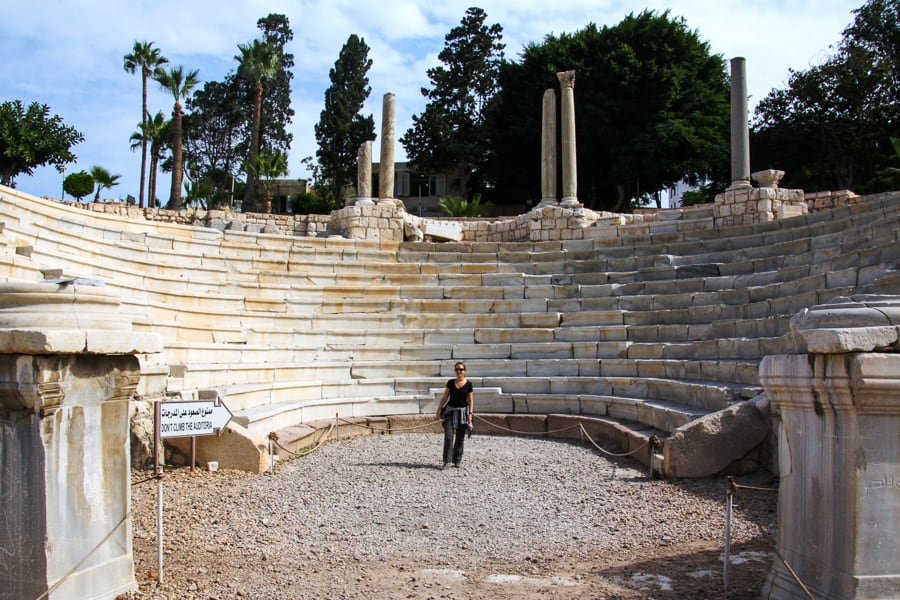
Alternative Option for Days 3 and 4 – Escape to the Desert
For something completely different to Cairo and Alexandria sightseeing, an alternative option for Days 3 and 4 of this itinerary is a 2-day guided tour (or day trip) into the Egyptian Sahara to visit the Bahariya Oasis, see the extraordinary landscapes of the Black Desert and White Desert National Park, and camp out under the stars.
Epic dunes, amazing formations, sunset and sunrise in the desert – this is one trip that is high on our bucket list of things to do next time we visit Egypt.
Day 5 – Memphis, Dahshur & Saqqara
Highlights: Memphis & Colossal Statue of Ramses II | Red & Bent Pyramids of Dahshur | Necropolis of Saqqara & Step Pyramid of Djoser
Overnight: Sleeper train to Aswan
Morning & Afternoon
Today we journey south of Cairo to see the evolution of Egypt’s early pyramids and temples on a day trip to Memphis, Dahshur and Saqqara.
We negotiated with a cab driver that we met on one of our trips around the city to ferry us about for half a day, but this is also a very popular and easy-to-organise half or full day guided tour from Cairo.
The Giza pyramids may be Egypt’s most famous, but there are actually dozens of pyramids scattering the desert south towards – and beyond – the ancient city of Memphis, Egypt’s thriving capital for much of the Pharaonic age.
Little remains of ancient Memphis today apart from a small, dusty open-air museum centred around a covered, colossal statue of Ramses II. The sheer scale and stonemasonry skill of this fallen giant make Memphis worth the visit, if not much else.
Ten kilometres (6 miles) further south of Memphis are the Red and Bent Pyramids of Dahshur – the oldest ‘true’ pyramid and its practice-run contemporary.
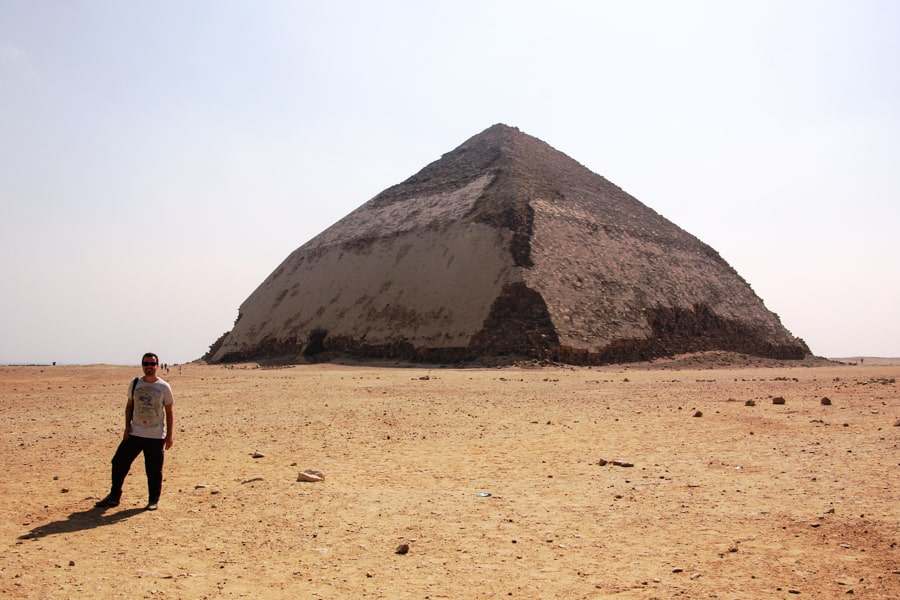
The focus of today’s trip, however, is the extraordinary Necropolis of Saqqara to the west of Memphis. Saqqara was in use as a cemetery for more than three thousand years and it is vast. You could easily spend the entire day here so either come armed with a guidebook or arrange a guide.
The most obvious highlight of Saqqara is the funerary complex and step pyramid of Djoser. This is Egypt’s very first pyramid and the world’s oldest.
Other must-sees include the excellent Imhotep Museum and, if they’re open, the Pyramids of Unas and Teti, with their pyramid text-inscribed walls; the Serapeum, burial place for the sacred bulls of the Apis cult; and the mastaba tombs of Kagemni and Ti.
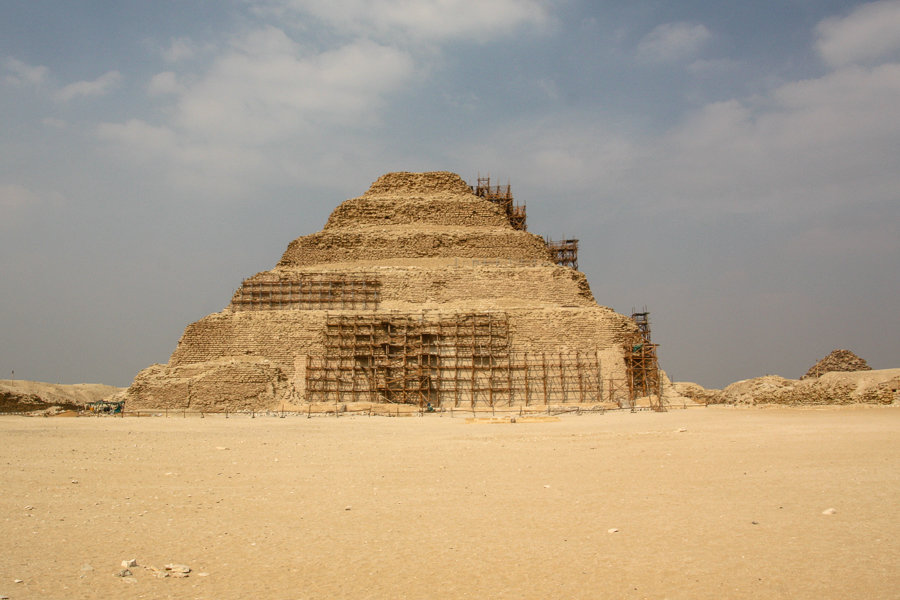
Evening
Tonight, we farewell Cairo and head south on the overnight train to Aswan.
You could fly this leg but having taken the overnight train twice, we can tell you that it really adds another dimension to your Egypt travel itinerary. Plus you’ll be covering ground while you sleep.
The sleeper train departs Cairo from Ramses Train Station, usually between 7pm and 8pm. It stops shortly after at Giza Train Station before heading south and making several stops en route to Aswan, including at Luxor. The journey to Aswan takes around 13 to 14 hours.
Tickets can be booked online at Abela Trains, or ahead of time at their train station office. As this is a popular method of travel between Cairo and the south, seats and beds can fill up quickly so once you have your itinerary locked in, book your tickets in advance.
Day 6 – Aswan Sightseeing
Highlights: Nubian Museum | Elephantine Island & Ruins of Yebu | Sunset Felucca Sail on Nile
Overnight: Aswan
Aswan is Egypt’s most southern city, a frontier town infused with thousands of years of lived history. For much of its past, Aswan was a key trading stop on the African caravan route and, for the ancient rulers of Egypt, a vital military outpost. Aswan also stretches along a lovely sweep of the Nile, making it a great place to relax by – and on – the river.
Assuming there have been no delays, your overnight train will pull into Aswan between 8am and 9am. Head straight to your accommodation, drop off your bags, freshen up and then head out exploring – there are lots of things to see in Aswan.
If you’re planning to do a Nile cruise, you’ll be joining your river boat tomorrow and many cruise itineraries include a guided tour to Aswan’s major sites on the first afternoon. They usually visit the High Dam, the Temple of Philae and the Unfinished Obelisk.
Therefore, depending on the itinerary of your chosen Nile cruise, we’ll use today to visit some of Aswan’s other important sites.
Morning – Nubian Museum
We recommend a couple of hours at the excellent Nubian Museum. This was a surprise highlight for us. The museum offers a fascinating journey through 6,500 years of history and culture in Nubia, the land that stretches away from Aswan south to Khartoum in Sudan. Nubia gave rise to one of the world’s oldest civilisations and has a major role in Egypt’s ancient story.
The museum also highlights the extraordinary works in the 1960s to save Nubia’s history and monuments ahead of the building of the High Dam and the flooding of the vast area now beneath Lake Nasser – useful insights ahead of your visits to the relocated temples at Philae and Abu Simbel.
Afternoon – Elephantine Island
A cheap and easy public ferry ride from Aswan will take you to Elephantine Island in the middle of the Nile. At the southern end of this large island, you’ll find the Ruins of Yebu, part of the ‘Nubian Monuments’ World Heritage area.
There’s a museum where you can pick up a brochure guide to the ruins. Highlights include the Temples of Khnum and Satet and there’s a viewpoint overlooking the vast area.
Our favourite spot in Yebu is the Nilometre, down by the water near the museum. This was an ancient means of measuring the height of the Nile waters and predicting the annual Nile flood, which in turn helped to set taxes.
Sunset – On the Water
In our opinion, Aswan is the best place in Egypt for a sunset felucca sail on the Nile. You’ll have opportunities to sail on a felucca in Cairo and Luxor as well, but if you do it just once on this 2 week Egypt itinerary, then do it here.
Feluccas are small, traditional boats with canvas sails. You can do multi-day Nile cruises on them but they’re pretty basic – you sleep on deck and they don’t have facilities. In our opinion, far better to enjoy them for a gentle hour or so of sailing.
Having said that, choosing and negotiating a felucca ride on your own can be an experience in itself and you may not end up with quite what you imagined; something we discovered the hard way. Our takeout: avoid the hassle, and arrange a sunset felucca trip through your hotel.
Where to stay in Aswan
In Aswan, you’ll find most accommodation along the Nile Corniche on the east bank of the river, and on Elephantine Island in the middle of the river.
The Nile Corniche is the more convenient of the two for getting out and about and visiting attractions such as the Nubian Museum and the Unfinished Obelisk.
However, Elephantine Island has a more peaceful, low-key vibe, plus you’ll find the World Heritage Ruins of Yebu here. There are also lots of budget accommodation options. There’s a public ferry to and from the island (it’s very cheap and you’ll pay one way only), but you can also arrange a felucca to the island pretty much anywhere along the Corniche.
Wherever you choose, go for something with either a rooftop or riverside area where you can enjoy the breeze and the Nile views Aswan is renowned for.
We stayed at the Obelisk Nile Hotel Aswan, a nice mid-range hotel on the Nile Corniche. We particularly liked the terrace overlooking the Nile, the perfect spot to wind up the day with a drink at sunset. Some other options with great reviews in Aswan include:
- Budget (Elephantine Island): Airkela Nuba Dool2
- Indulge (Aswan): Sofitel Legend Old Cataract
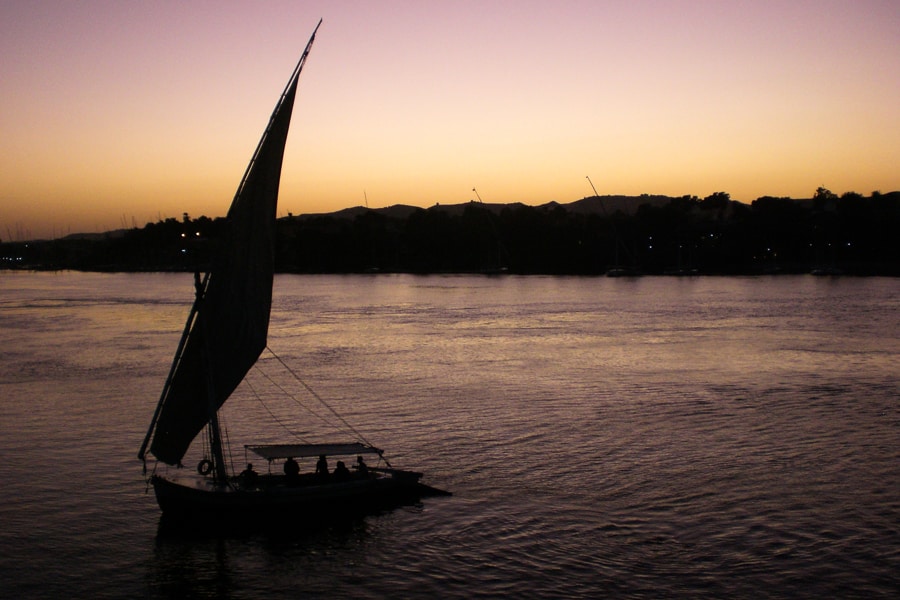
Day 7 – Abu Simbel
Highlights: Great Temple of Ramses II & Temple of Hathor at Abu Simbel
Overnight: Aswan
It takes a bit of effort to get there, and you’ll need a whole day, but World Heritage Abu Simbel is right up there with the Pyramids of Giza and Karnak Temple as one of the country’s most monumental sites. The story of its modern incarnation is equally epic. In our opinion, Abu Simbel is an absolute must for an Egypt 2 week itinerary.
There are two rock-cut temples at Abu Simbel. The largest and most famous is the Great Temple of Ramses II, with its four colossal seated statues of the king keeping eternal watch over the ancient southern borders of his kingdom. Nearby is the smaller, but no less impressive rock-cut Temple of Hathor, with four huge standing statues of Ramses II and two of his favourite wife, Queen Nefertari.
These 13th century BC temples are extraordinary in and of themselves. What makes them even more exceptional is the fact that they were moved here, stone by stone, from somewhere else.
Unbelievable as it may seem, under threat of being lost forever with the building of the High Dam and the creation of Lake Nasser in the 1960s, both temples were completely dismantled, relocated and meticulously reassembled on the high ground where they are today. Mind blowing.
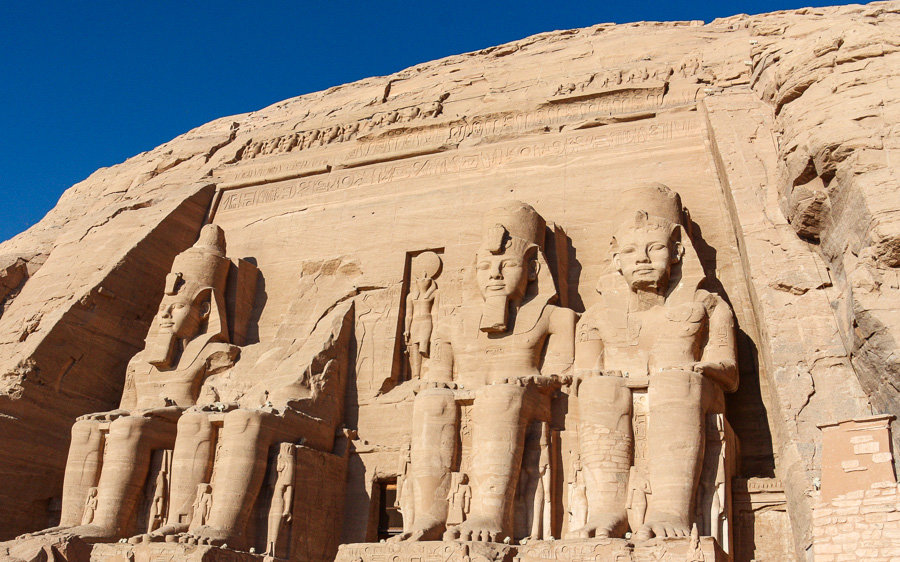
You have two options for getting to and from Abu Simbel out of Aswan – by road or by plane.
We travelled to Abu Simbel by road, a journey of close to 300km (186 miles) and up to 3 hours each way. We organised our trip to Abu Simbel through our hotel in Aswan, joining a van with a group of others and travelling as part of a convoy (we understand the convoy is no longer required). You can also book ahead on a guided day trip.
On arrival, we had about two hours to explore the temple complex before heading back. If travelling by road, you can expect the day to last between 8 and 10 hours.
The alternative is a return flight from Aswan to Abu Simbel. This is a more expensive option but the flight is around 45 minutes each way. Make sure you book a return flight that gives you a couple of hours at the temples. With travel to and from the airport, waiting for flights and time at the temples, this option will take around 7 to 8 hours.
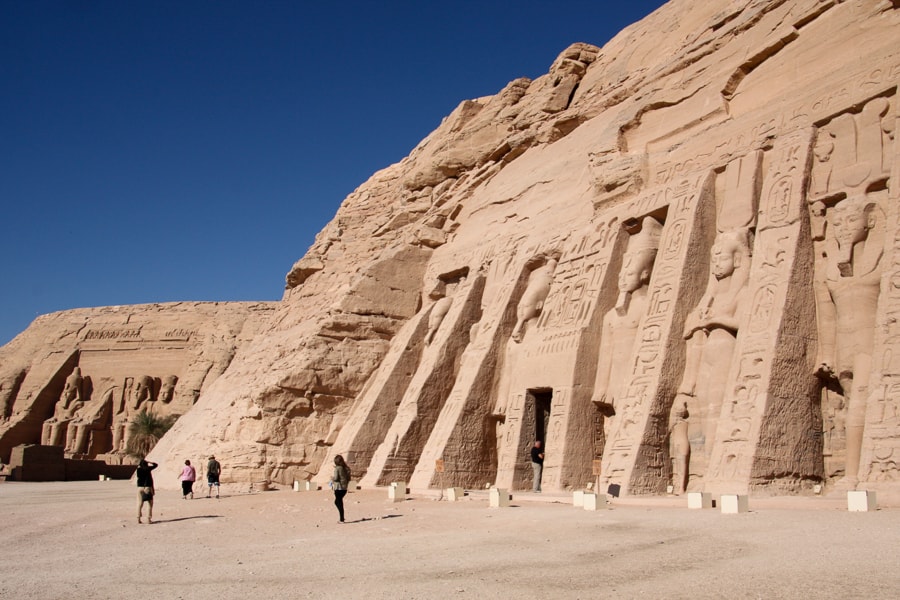
Days 8 to 11 – Nile Cruise from Aswan to Luxor
Just about everyone planning a trip to Egypt will consider a Nile cruise. You’ll see boats of all sizes voyaging in both directions between Luxor and Aswan, from feluccas and traditional dahabiya boats to large river cruise ships.
Nile cruises generally last from three to seven nights. The type of boat you choose, the length of your trip and the itinerary for that cruise will determine which sites you visit along this stretch of the Nile.
It’s important to note that while the larger cruises will generally always stop en route at the Temples of Kom Ombo and Edfu, they usually spend their first and last nights docked near Luxor and Aswan with other tourist boats.
For this 2 week Egypt itinerary, we’ve included a typical 4 Day/3 Night Nile cruise so that you can experience the magic of travelling on the Nile, while also having enough time to see all the main sites of Cairo, Alexandria and Luxor.
If you’d prefer not to do a Nile Cruise, you can substitute the following river cruise leg with overland travel, going by car or train between Aswan and Luxor. Instead of three nights on a boat, look to spend an extra night in Aswan and two extra nights in Luxor. If you arrange a car and driver for Day 9, you’ll be able to visit the Temples of Kom Ombo and Edfu on the way to Luxor.
Nile Cruising
I’ve cruised the Nile aboard a large 100-passenger riverboat over four days, and John and I have also travelled together on a small and beautiful 16-passenger dahabiya boat over six days. Both experiences were memorable, but the dahabiya cruise remains one of our all-time favourite Egypt experiences.
We stopped at places along the Nile where the larger cruise boats could not dock, meaning we saw more off-the-beaten-track ancient sites and much more of the local way of life along the river. We’ve written about this experience in our Sailing the Nile Aboard a Dahabiya post.
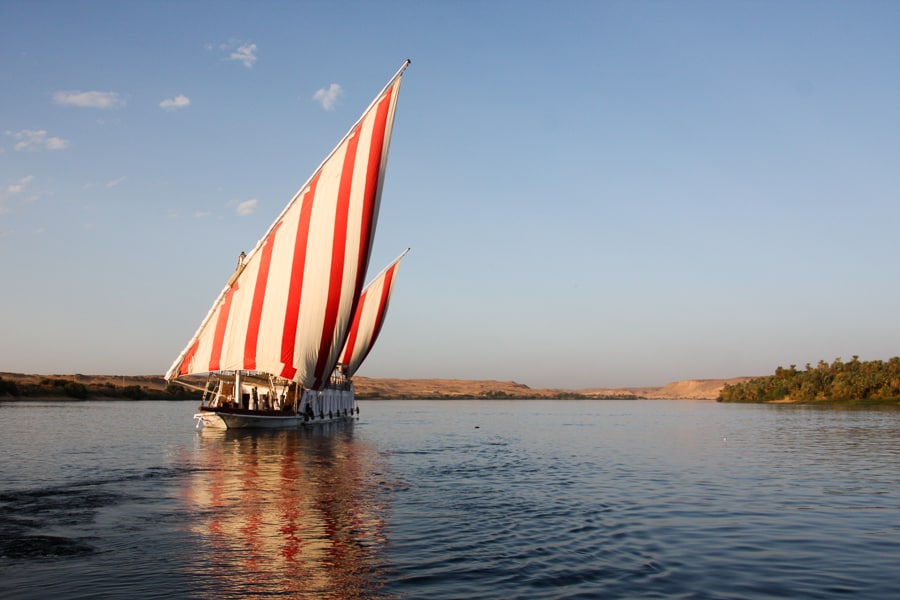
Days 8 to 11 of this itinerary are based on a typical 4 Day/3 Night Nile Cruise. What you see on these days may vary depending on the cruise you choose.
Day 8 – Nile Cruise with Aswan sightseeing
Highlights: Aswan High Dam | Unfinished Obelisk | Temple of Philae
Overnight: On board Nile Cruise (or Aswan if you’re overlanding this leg)
Today you’ll join your Nile Cruise in Aswan. The typical 4 Day/3 Night itinerary will include guided tours of several ancient sites in and around Aswan, usually the High Dam, Temple of Philae and the Unfinished Obelisk.
If your Nile cruise doesn’t include a tour of the following sites in Aswan, we would rework Day 6 of this Egypt 2 week itinerary to take in the Temple of Philae and the Unfinished Obelisk as well as the Nubian Museum.
If you’re overlanding this leg rather than joining a Nile cruise, plan to spend an extra night tonight in Aswan and visit the sites below today.
Unfinished Obelisk
Much of the granite used in the temples and statuary of Pharaonic Egypt came from around Aswan, and you’ll see the Unfinished Obelisk in one of these ancient stone quarries. Work started some 3,500 years ago on this massive pink granite obelisk for the prolific builder and pharoah Queen Hatshepsut. Had it been finished, it would have been the largest obelisk ever created. Alas, a flaw turned up in the stone and it was abandoned.
Temple of Philae
The elegant Temple of Isis at Philae, also part of the Nubian Monuments World Heritage area, originally graced a site near the First Cataract of the Nile. It was completely dismantled and moved 500 metres away to higher ground on Agilkia Island in the 1960s, to protect it from flooding when the Aswan High Dam was built. Approaching the site by boat is a wonderful part of the experience of visiting this picturesque sanctuary.
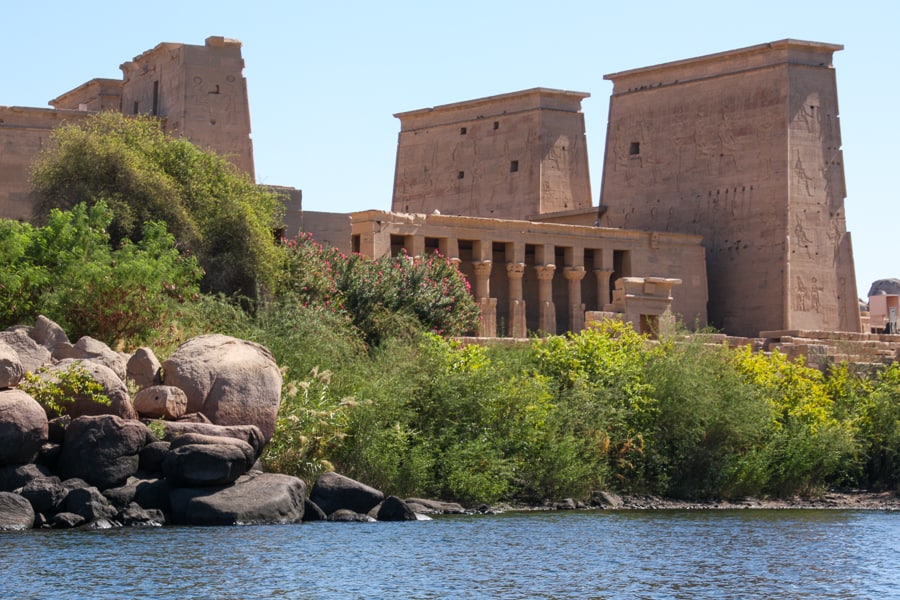
Day 9 – Nile Cruise & Kom Ombo
Highlights: Nile Cruising | Temple of Kom Ombo | Crocodile Museum
Overnight: On Board Nile Cruise (or Luxor if you’re overlanding this leg)
Today, you’ll get to enjoy the timeless greenery-meets-desert scenery edging the Nile as you cruise north towards the temples of Kom Ombo and Edfu, typical stops on most Nile Cruises.
If you’re overlanding instead of cruising this leg, we would recommend arranging a car and driver today and travelling from Aswan to Luxor via the temples at Kom Ombo and Edfu, as well as the Temple of Khnum at Esna.
Temple of Kom Ombo
The beautiful Nile-side Kom Ombo is a dual temple dedicated to two gods, with symmetrical twinned sides. The left side is dedicated to the falcon-headed god, Haroeris (Horus the Elder) while the right side is dedicated to the crocodile-headed god, Sobek.
Crocodiles were sacred to Sobek and nearby the temple you’ll find the Crocodile Museum, which has a fascinating collection of mummified reptiles found at the temple.
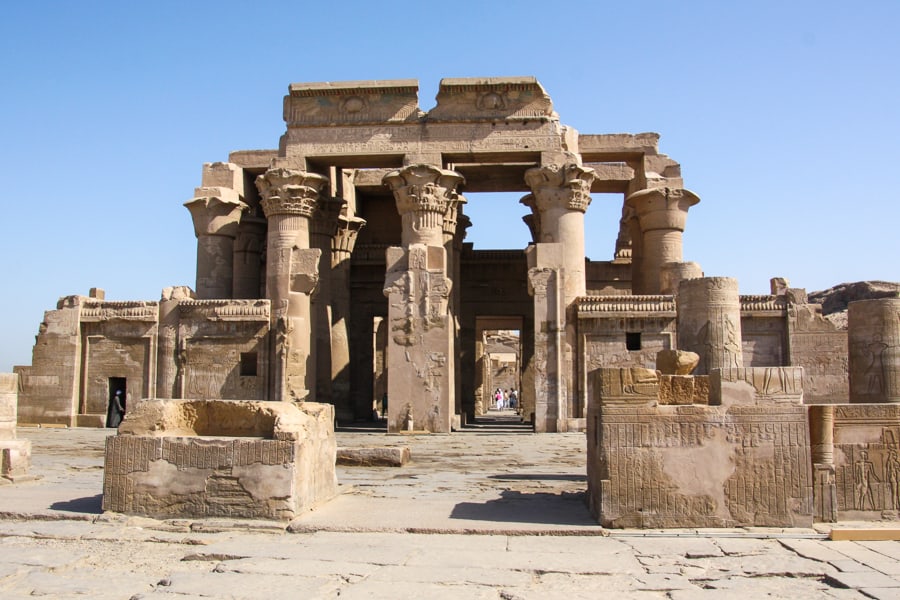
Day 10 – Nile Cruise, Edfu & Luxor East Bank
Highlights: Nile Cruising | Temple of Edfu | Temples of Karnak | Luxor Temple by Night
Overnight: On Board Nile Cruise (or Luxor if you’re overlanding this leg)
Edfu is another major temple typically included in a Nile Cruise itinerary. Many cruises will sail on to Edfu after Kom Ombo, docking in Edfu overnight so that you can visit this temple early in the morning of your third day cruising.
The cruise then continues on to Luxor, where you’ll spend the afternoon visiting the epic Temples of Karnak and the Temple of Luxor on a guided tour.
If you’ve overlanded instead of Nile cruising, you’ll have visited Edfu yesterday and will wake up today in Luxor, giving you the whole day to explore the temples of Karnak and Luxor.
Temple of Edfu
The striking Temple of Horus at Edfu is one of the best preserved temples in Egypt. It was built by the Ptolemaic pharaohs over a 200 year period and completed in 57 BC. Giant reliefs of Pharoah Ptolemy XII smiting his enemies ornament the 36-metre-high entrance pylon.
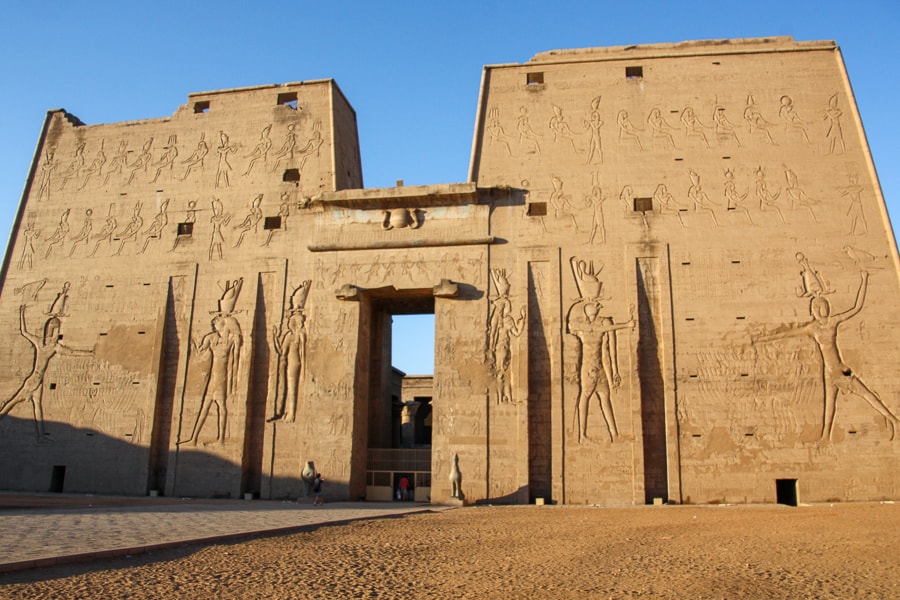
Temples of Karnak
The World Heritage site of Karnak is one of our top five Egypt highlights. Built and expanded on over a thousand years, and centred around the biggest religious structure ever built – the Temple of Amun-Ra – Karnak was once Egypt’s most important place of worship.
Today, it’s a vast historical treasure trove of temples, courts, halls, pylons, decorated columns, statues, obelisks, and an epic avenue of sphinxes.
You could spend days wandering here. We had a good half-day and we barely scratched the surface. We considered exploring ourselves, but believe us when we say a guided tour makes all the difference in giving you a meaningful introduction to this enormous time capsule. Our guide, who we engaged at the site, also pointed out myriad hidden gems we’d have never spotted on our own.
A guided visit to Karnak is usually included in typical 4-day Nile Cruise tours. If you want more time here, consider coming back on one of the extra days we have in Luxor in our 2 week Egypt itinerary. Tickets for Karnak can be bought at the site.
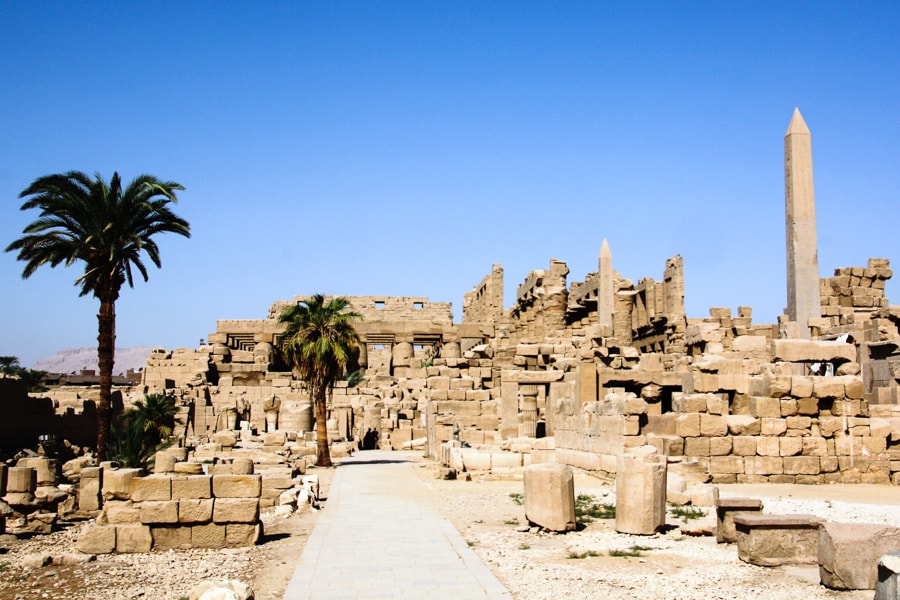
Luxor Temple
Also located on Luxor’s East Bank is the elegant Luxor Temple, a New Kingdom sanctuary built around 3,400 years ago. Some of the big hitters of ancient Egypt left their stamp here, like Amenhotep III and Ramses II. The young Tutankhamun also had a significant role in the decoration of the striking Great Colonnade Hall, with its 28 beautiful lotus-shaped columns.
The temple is particularly ambient at night, when the site is all lit up (there’s a sound and light show here too). You can buy tickets for Luxor Temple at the site.
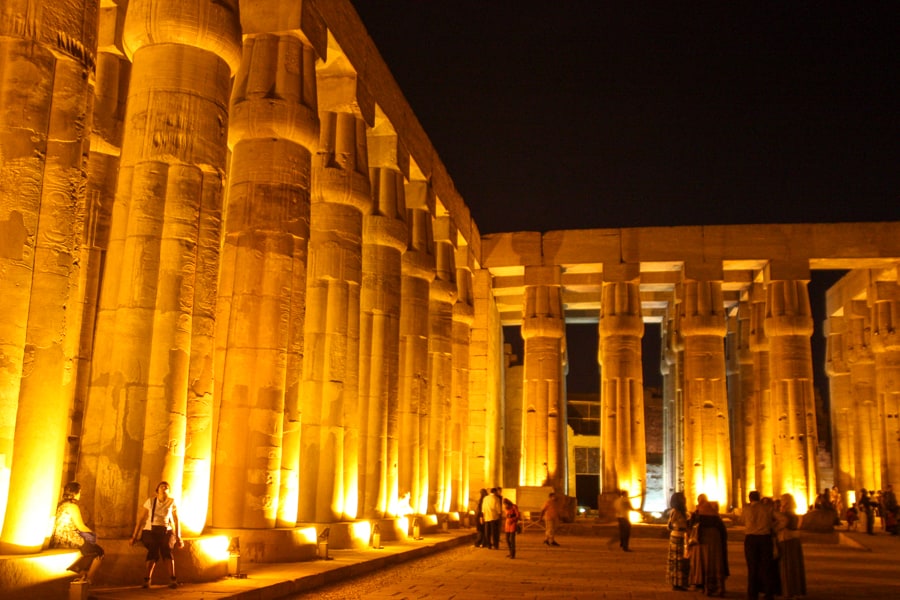
Day 11 – Nile Cruise & Luxor West Bank
Highlights: Valley of the Kings | Temple of Hatshepsut
Overnight: Luxor
A typical 4-day Nile cruise will finish today after breakfast, but will often include a guided day trip to Luxor’s West Bank, taking in the following sites.
If you haven’t done a Nile cruise, this will be your second full day in Luxor and you’ll also visit the sites below.
Valley of the Kings
Barren, dusty and hot on the surface, it’s hard to imagine the extraordinary wealth of ancient art (and on rare occasions treasure) that lies beneath the ground in the labyrinthine tombs of the Valley of the Kings.
This is where the pharaohs of Egypt’s New Kingdom built their lavish portals to the afterlife. More than 65 tombs have been uncovered. While most were plundered of their rich grave goods in antiquity, those that can be visited today are beautifully decorated and still vivid with colour.
Tickets for the Valley of the Kings include entry to three tombs from a list of those open at the time you visit.
There are a couple of other tombs that can also be visited with an extra ticket and fee for each. These include the tombs of Tutankhamen (KV62), Seti I (KV17) and Ramesses V and VI (KV9). We highly recommend spending the extra money to visit KV17 and/or KV9; these were our favourite tombs in the valley.
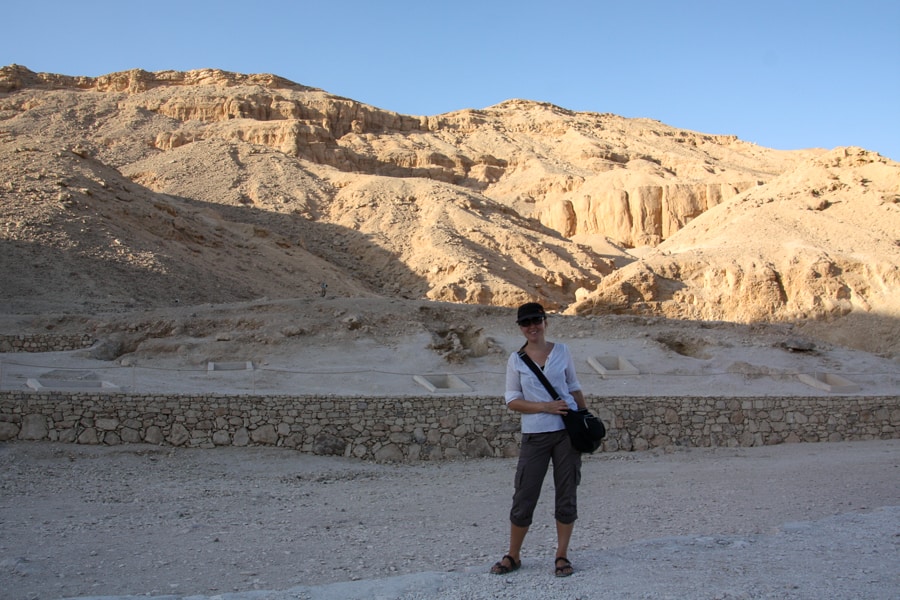
Mortuary Temple of Queen Hatshepsut
Tucked into the base of the soaring cliffs at Deir el-Bahri, the huge three-tiered Mortuary Temple of Hatshepsut looks almost like it was built recently. At 3,500 years old, it definitely wasn’t but Egypt’s longest reigning female pharoah did make sure her shrine took an entirely new direction in temple building. It’s a fascinating site, but can be very, very hot. If visiting independently, you can buy your entry ticket at the site.
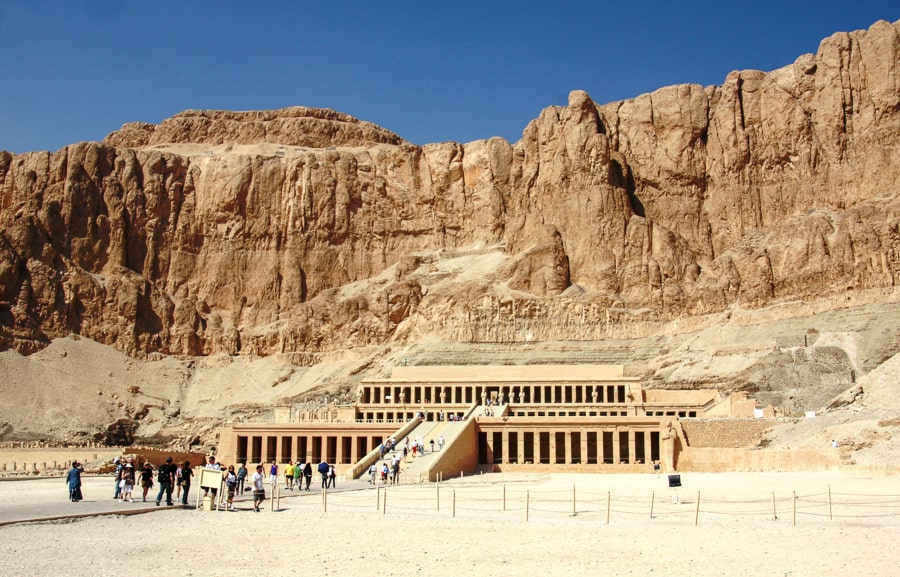
Where to stay in Luxor
Most visitors to Luxor will stay in the town on the East Bank of the Nile. The Temples of Karnak and Luxor are on this side.
There are also plenty of places to stay on the quieter, greener, more atmospheric West Bank, which is where you’ll find the Valley of the Kings, Valley of the Queens, the Temple of Hatshepsut and much more. This is the side we stayed on and we loved the feeling of being in the midst of a place so ancient.
You’ll find accommodation at various price points in Luxor; just bear in mind that this is a major destination for tourists so it pays to book ahead, particularly in peak season. Some options for Luxor with excellent reviews include:
- Budget (West Bank): Villa Kaslan Apartments
- Mid-range (West Bank): New Memnon Hotel
- Indulge (East Bank): Pavillon Winter Luxor
Days 12 and 13 – Luxor
Highlights: Colossi of Memnon | Valley of the Queens | Workmen’s Village at Deir el-Medina | Tombs of the Nobles | Ramesseum | Temple of Medinet Habu
Overnight (both nights): Luxor
In our view, just 2 days in Luxor is not enough. This is ancient Thebes, the thriving heartland of the New Kingdom for many hundreds of years. Kings and queens left their enduring legacy in what is today one of the most extraordinary epicentres of ancient temples and tombs in the world.
In fact, there’s so much to see in Luxor that we recommend devoting an extra couple of days – the final days of your 2 weeks in Egypt – to this extraordinary place.
You could use these two days to head back to Karnak for a morning or spend another couple of hours marvelling at more tombs in the Valley of the Kings. On the East Bank, you’ll also find the small Mummification Museum along the Luxor Corniche.
There are also plenty of other sites on Luxor’s West Bank that you might consider visiting over the next two days. We recommend the sites below.
Travel Tip: Tickets are required for most sites on the West Bank. You can buy tickets for the Valley of the Kings, Valley of the Queens and the Temple of Hatshepsut at each of those sites.
For all other ticketed sites, you’ll need to buy your tickets in advance from the West Bank Ticket Office (also called the Antiquities Inspectorate Ticket Office), which is just down the road beyond the Colossi of Memnon.
Colossi of Memnon
It’s possible you’ll stop by these two forlorn-looking colossal statues during your Nile Cruise guided tour to Luxor’s West Bank. If not, it’s worth a quick visit. Once adorning a temple complex thought to be even larger than Karnak, the eroded twin giants – which depict the 14th century BC pharaoh Amenhotep III – are all that remains of his mortuary temple today. Entry is free.
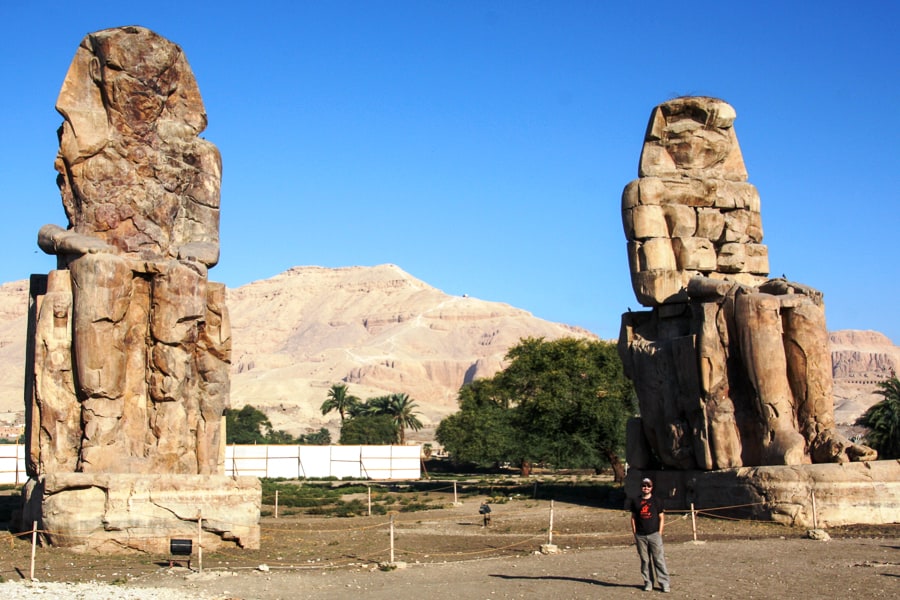
Valley of the Queens
While most visitors to Luxor make a beeline for the Valley of the Kings, in the nearby Valley of the Queens there are more than 90 other tombs that once served as the final resting place for the queens, princesses and high-ranking officials of the New Kingdom.
Tickets are bought at the Valley of the Queens ticket office and three tombs are included in the general entry ticket.
The star of the show, however, is the Tomb of Nefertari (QV66), which isn’t included in the general ticket and costs quite a bit extra. For good reason too. This is considered one of the most beautiful tombs in the country, if not the most beautiful.
Nefertari (you’ll recognise her from Abu Simbel) was Ramses II’s most beloved wife and her tomb is an exquisite and vividly-decorated love letter to her. It looks like it was painted yesterday and is absolutely worth paying extra to see.
There’s a daily limit on numbers for Nefertari’s tomb so if you’re visiting independently, head there first thing in the morning to up your chances of getting a ticket for this tomb.
Travel Tip: Like the Pyramids of Giza, Luxor and its sites are notorious for the level of hassle tourists can experience from touts, drivers, vendors, site ‘guardians’ and others.
As with the pyramids, the best thing you can do is be ready for it and be polite but firm in your position. Don’t be pressured and avoid making loose commitments like ‘maybe later’ or ‘I’ll think about it’ unless that’s actually the case.
We also found it useful to carry small denomination notes and loose change as baksheesh for those who do provide a good or helpful service.
Workmen’s Village at Deir el-Medina
If you’re visiting the Valley of the Queens, we also suggest you swing by the Workmen’s Village at Deir el-Medina. This is where the labourers and artisans who worked in the valleys lived.
There are four tombs you can visit, though not all are open at the same time. They are the tombs of Sennedjem, Irynefer, Inherka and Peshedu (the last costs extra). While these tombs are small, they more than make up for their size with their decoration and the glimpse they give into the lives of ordinary ancient Egyptians.
Tickets can be bought at the West Bank Ticket Office. Of the three tombs we visited, the Tomb of Sennedjem was our favourite. The exceptional artwork here convinced us this master artist left some of his best work for his own final resting place.
Tombs of the Nobles
Between Deir el-Medina and the Temple of Hatshepsut, you’ll find the Tombs of the Nobles. Clustered into groups in the rocky hillside, these are the tombs of governors, administrators and other high-ranking officials of ancient Thebes. It’s less straightforward to visit these tombs without a guide, though if you do, you’re likely to have the (insistent) assistance of a site guardian in return for a bit of baksheesh.
You’ll need to choose which tomb clusters you want to see in advance when you purchase your tickets at the West Bank Ticket Office.
We chose the tombs of Sennofer and Rekhmire, both beautifully adorned with vivid scenes from their daily lives (we felt a particular connection with Sennofer who covered the ceiling of his tomb in grapevines). We’ve also heard the tomb of Ramose is outstanding.
Ramesseum
Near the Tombs of the Nobles lies the hulking ruin of the Ramesseum, a great mortuary temple built by Ramses II to ensure his everlasting veneration. Despite suffering the ravages of time, it’s still an impressive monument, especially when you come face to face with the colossal head and shoulder of the self-appointed god-king lying in the sand. Entry for this temple is purchased at the West Bank Ticket Office.
Medinet Habu
We could see the towering entrance pylon of this less-visited temple complex from the roof terrace of our accommodation on Luxor’s West Bank. It turned out to be another of our top Egypt highlights.
Huge mudbrick walls surround a complex of courtyards and halls, but the centrepiece of Medinet Habu is the great Temple of Amun. The walls and columns here are absolutely covered in beautiful, well-preserved reliefs and heiroglyphs, showing scenes and telling stories of military exploits, religious ceremonies and rituals that took place under the rule of Ramses III. Entry tickets can be purchased from the West Bank Ticket Office.
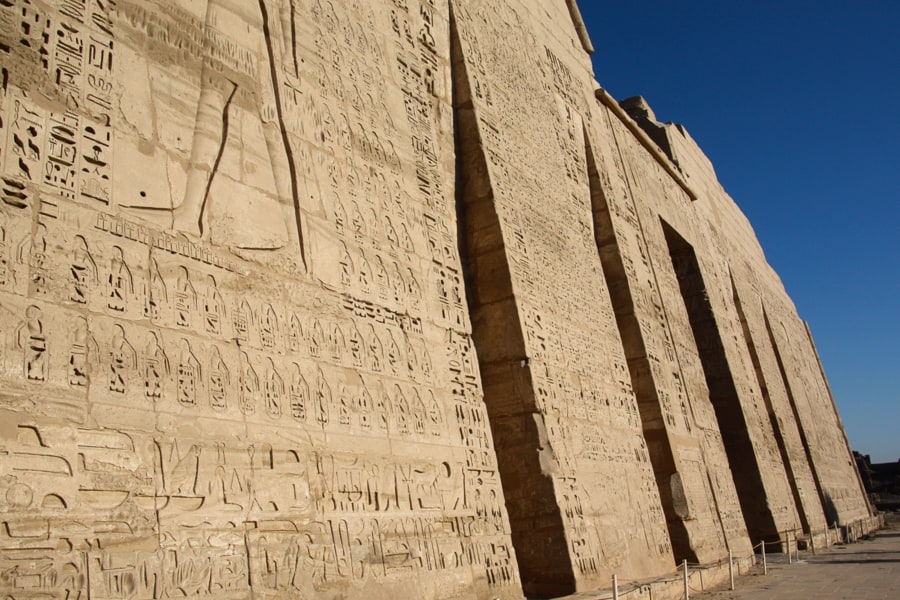
The Epic Temples of Dendera and Abydos
If you’re looking for something else to do, or you have an extra day in Luxor and the stamina for one last big day trip, consider visiting the superb temples of Dendera and Abydos, to the north.
These are two of the most important temples in the country. Dendera’s Temple of Hathor is also considered one of Egypt’s most beautiful temples.
While you can visit independently by train or taxi, trying to do both temples in a day would be time-consuming and a bit of a hassle. The most straightforward means of visiting both is to organise a day tour from Luxor. It’s an all-day affair, a lot of driving and it isn’t cheap, but by all accounts it’s worth it. These temples are definitely on our bucket list for a future visit!
Day 14 – Depart Luxor
Our 2 week Egypt itinerary ends today in Luxor.
If you have time in the morning, you could wind up this epic itinerary for Egypt with a dawn hot air balloon ride. We haven’t personally experienced this, but it does look like a beautiful, serene way to get a feel for the ancient capital of Thebes from on high.
This is a pre-dawn start so you could be up and back before check-out time, but do confirm how long the whole experience will take when you book.
From Luxor, you can take a day train or a bus back to Cairo (a journey of around 10 hours). Or you can fly out of Luxor to Cairo and onwards home. Luxor Airport also connects with various other Egyptian, Middle Eastern and European destinations.
Time to start planning your return!
If you have any questions about this Egypt travel itinerary or Egypt trip planning, drop us a message below!

Thanks for your comment! Egypt really is a remarkable country, one we love and look forward to returning to. Like any country, there are sometimes cultural aspects – like the tradition of Baksheesh – that can be confronting at first for a visitor. Making an effort to understand and engage with things like this can enhance an experience greatly, we’ve found.